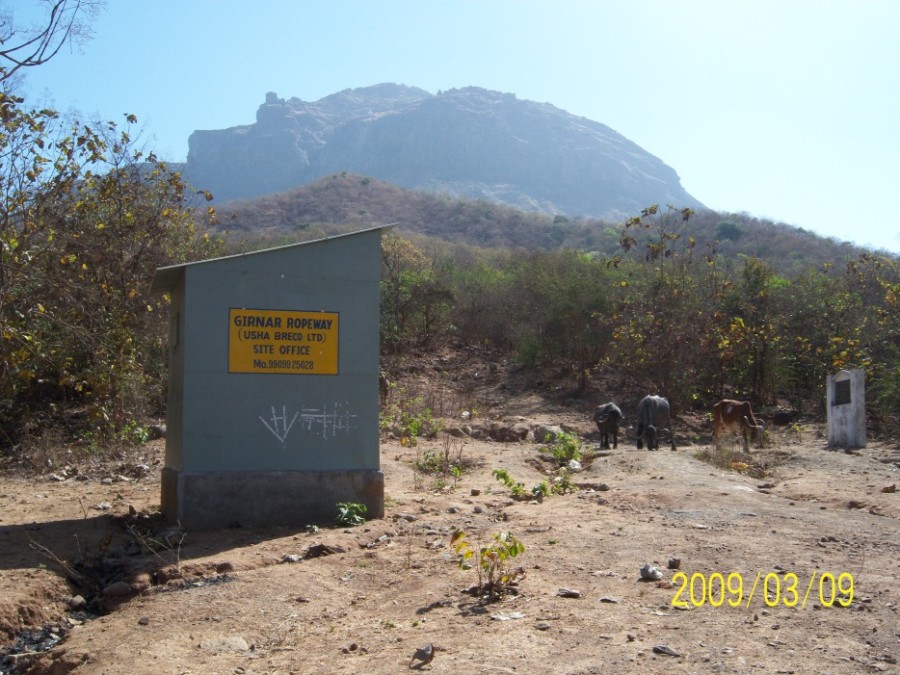Chapter outline and page reference:
Girnar Aerial Ropeway Project 290
Girnar Helicopter Service 292
Funicular Train Project 293
Chapter preview (first three pages only):
Figure 43. Very modest structural beginnings of the Girnar ropeway project (photo by Wainer 2009).
Girnar Aerial Ropeway Project
The Girnar ropeway was first envisaged in the 1960s by the Porbandar based industrialist, Nanji Kalidas Maheta. During the 1968 Lok Sabha Debates it was noted by the Minister of Tourism and Civil Aviation Dr Karan Singh that (Lok Sabha 1968): ‘A proposal was received through the Government of Gujarat in June, 1962 requesting for assistance to Shri Nanji Kalidas of Porbunder in fhe issue of an import licence for importing ropeway machinery to be installed at Girnar’.
Since then, announcements to launch the project have been made many times, following promises by former chief ministers. The most recent cost estimate is Rs 89.31 crore (Usha Breco Ltd 2009a). It was estimated in 2007 to cost Rs 70 crore (700 million rupees). The project was supposed to be completed in 1972 for an estimated Rs 9.5 crore. The ropeway is planned to be 2.382 km long, crossing a horizontal distance of 2.171 km, and it would lift people up to a height of 870 m to Ambaji Peak of Mount Girnar. The project was designed with an optimum capacity of transporting 1000 passengers per hour (8 people per cabin) with rope speed of 4.0 metres/second. The travel time is estimated at 9.28 minutes. The ropeway would pass through over 1,700 meters of forest area.
Environmentalists allege that the project would lead to severe eco-destruction (e.g. Saghal 2002, Patra 2011, Sarkar 2011). There are fears that the resident lions, and the nesting and roosting Schedule–I vultures would be threatened (Express News Service 2009). It has been estimated that 15,000 trees would be felled in the proposed 7.3 ha of land earmarked for the project, whereas others claim that 40,000 trees would be felled. An equal area of land, at Torania village, near Bilkha, to the south-east of Girnar, has been allotted by the government to grow around 25,000 trees (Times of India 2004; Dave 2007). Species like amla (Phyllanthus emblica), aritha (Sapindus emarginatus), tamarix (Tamarix stricta), jamun (Syzygium cumini), sitafal (Annona squamosa) and other varieties have been planted.
The Forest Department has allotted land for the ropeway, a survey has been conducted by a Kolkata based company, and a foundation laying ceremony has taken place, but no start has been made on its construction. While the Hindu temple bodies favour a ropeway project, the Jain community fears Girnar’s sanctity will be at stake if the project commences. Apparently many people have already acquired large tracts of land at the base of the mountain for shopping complexes, hotels and restaurants, expecting a huge inflow of tourists. The Hindu bodies are irked because they believe the Jain lobby has succeeded in delaying the project using political pressure.
The ropeway is to be constructed by Usha Breco Ltd., the company whose ropeway at Pavagadh Hill, 50 km from Vadodara in Gujarat, collapsed in January 2003, leaving seven dead and 45 injured (Dasgupta 2003). The company’s passenger aerial ropeway projects are termed ‘Udankhatola’ (Usha Breco Ltd 2009a).
The Committee of the National Board for Wildlife believed that the construction of the ropeway might cause the local extinction of vultures at Girnar. The Committee visited the site in December 2010 and advised against
